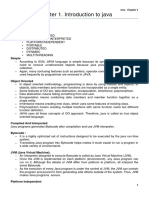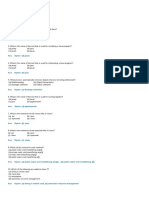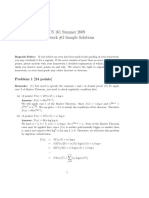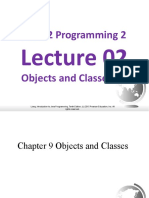PDC - Cs Department Java Programming Sae4A
PDC - Cs Department Java Programming Sae4A
Uploaded by
SrinivasaRao JJCopyright:
Available Formats
PDC - Cs Department Java Programming Sae4A
PDC - Cs Department Java Programming Sae4A
Uploaded by
SrinivasaRao JJOriginal Title
Copyright
Available Formats
Share this document
Did you find this document useful?
Is this content inappropriate?
Copyright:
Available Formats
PDC - Cs Department Java Programming Sae4A
PDC - Cs Department Java Programming Sae4A
Uploaded by
SrinivasaRao JJCopyright:
Available Formats
PDC – CS Department Java Programming SAE4A
Unit 1: Life Cycle-Graphics Programming-Managing Input/Output Files: Concept of
Introduction to Java-Features of Java-Basic Concepts of Object Oriented Streams-Stream Classes-Byte Stream Classes-Character Stream Classes – Using
Programming-Java Tokens-Java Statements-Constants-Variables-Data Types- Streams-Using the File Class-Creation of Files-Random Access Files-Other
Type Casting-Operators-Expressions-Control Statements: Branching and Stream Classes.
Looping Statements.
Unit-5:
Unit-2: Network basics –socket programming – proxy servers – TCP/IP – Net Address –
Classes, Objects and Methods-Constructors-Methods Overloading-Inheritance- URL – Datagrams -Java Utility Classes-Introducing the AWT: Working with
Overriding Methods-Finalizer and Abstract Methods-Visibility Control –Arrays, Windows, Graphics and Text- AWT Classes- Working with Frames-Working
Strings and Vectors-String Buffer Class-Wrapper Classes. with Graphics-Working with Color-Working with Fonts-Using AWT Controls,
Layout Managers and Menus.
Unit 3:
Interfaces-Packages-Creating Packages-Accessing a Package-Multithreaded
Programming-Creating Threads-Stopping and Blocking a Thread-Life Cycle of a
Thread-Using Thread Methods-Thread Priority-Synchronization-Implementing
the Runnable Interface
Unit-4:
Managing Errors and Exceptions-Syntax of Exception Handling Code-Using
Finally Statement-Throwing Our Own Exceptions-Applet Programming-Applet
Prepared by : S.P.Chitra Preetha Page 1
PDC – CS Department Java Programming SAE4A
UNIT 2 Steps to Compile and Run your first Java program
CLASS Step 1: Open a text editor and write the code as above.
Step 2: Save the file as Hello.java
First Java Program Step 3: Open command prompt and go to the directory where you saved your first
java program assuming it is saved in C:\
Let us look at a simple java program.
Step 4: Type javac Hello.java and press Return to compile your code. This
class Hello
command will call the Java Compiler asking it to compile the specified file. If there
{ are no errors in the code the command prompt will take you to the next line.
public static void main(String[] args) Step 5: Now type java Hello on command prompt to run your program.
{ Step 6: You will be able to see Hello world program printed on your command
System.out.println ("Hello World program"); prompt.
}
class : class keyword is used to declare classes in Java Now let us see What happens at Runtime
public : It is an access specifier. Public means this function is visible to all. After writing your Java program, when you will try to compile it. Compiler will
static : static is again a keyword used to make a function static. To execute a static perform some compilation operation on your program.
function you do not have to create an Object of the class. The main() method here Once it is compiled successfully byte code(.class file) is generated by the compiler.
is called by JVM, without creating any object for class.
void : It is the return type, meaning this function will not return anything.
main : main() method is the most important method in a Java program. This is the
method which is executed, hence all the logic must be inside the main() method. If a
java class is not having a main() method, it causes compilation error.
System.out.println : This is used to print anything on the console like printf in C
language.
Prepared by : S.P.Chitra Preetha Page 2
PDC – CS Department Java Programming SAE4A
After compiling when you will try to run the byte code(.class file), the following steps
are performed at runtime:-
1. Class loader loads the java class. It is subsystem of JVM Java Virtual machine.
2. Byte Code verifier checks the code fragments for illegal codes that can violate
access right to the object.
3. Interpreter reads the byte code stream and then executes the instructions, step
by step.
Definition: A class is a collection of objects of similar type. Once a class is
defined, any number of objects can be produced which belong to that class.
A class is declared using class keyword. A class contain both data and code that
operate on that data. The data or variables defined within a class are
called instance variables and the code that operates on this data is known
as methods.
Rules for Java Class
• A class can have only public or default(no modifier) access specifier.
• It can be either abstract, final or concrete (normal class).
• It must have the class keyword, and class must be followed by a legal identifier.
Prepared by : S.P.Chitra Preetha Page 3
PDC – CS Department Java Programming SAE4A
void display()
• It may optionally extend one parent class. By default, it will extend
{
java.lang.Object.
• It may optionally implement any number of comma-separated interfaces. System.out.println(“hai”);
• The class's variables and methods are declared within a set of curly braces {}. }
• Each .java source file may contain only one public class. A source file may }
contain any number of default visible classes.
• Finally, the source file name must match the public class name and it must have
OBJECTS
a .java suffix.
Objects are instances of the Class. Classes and Objects are very much related to
Class Declaration each other. Without objects you can't use a class.
class classname
{ Syntax
… variables;
Classname objectname = new classname();
Methods;
Myclass obj1 = new obj1();
…}
Accessing an object
Example
Dot operator is used to access the variable and methods of a class.
class myclass
Syntax
{
Object name . variablename;
Int a,b;
Prepared by : S.P.Chitra Preetha Page 4
PDC – CS Department Java Programming SAE4A
Objectname.methodname(); name=name+st;
return name;
Example }
Obj1.a;
Obj1.add();
Methods
A Java method is a collection of statements that are grouped together to perform
an operation.
Methods in Java
Method describe behavior of an object. A method is a collection of statements that
are group together to perform an operation.
Syntax :
return-type methodName(parameter-list) Modifier : Modifier are access type of method. We will discuss it in detail later.
{
Return Type : A method may return value. Data type of value return by a method is
//body of method declare in method heading.
} Method name : Actual name of the method.
Parameter : Value passed to a method.
Method body : collection of statement that defines what method does.
Example of a Method
public String getName(String st)
String name="StudyTonight";
Prepared by : S.P.Chitra Preetha Page 5
PDC – CS Department Java Programming SAE4A
Parameter Vs. Argument
1. call-by-value : In this approach copy of an argument value is pass to a method.
While talking about method, it is important to know the difference between two
terms parameter and argument. Changes made to the argument value inside the method will have no effect on
Parameter is variable defined by a method that receives value when the method is the arguments.
called. Parameter are always local to the method they dont have scope outside the
method. While argument is a value that is passed to a method when it is called. 2. call-by-reference : In this reference of an argument is pass to a method. Any
changes made inside the method will affect the agrument value.
NOTE : In Java, when you pass a primitive type to a method it is passed by value
whereas when you pass an object of any type to a method it is passed as reference.
Example of call-by-value
public class Test
public void callByValue(int x)
x=100;
public static void main(String[] args)
int x=50;
Test t = new Test();
t.callByValue(x); //function call
System.out.println(x);
call-by-value and call-by-reference
}
There are two ways to pass an argument to a method
Prepared by : S.P.Chitra Preetha Page 6
PDC – CS Department Java Programming SAE4A
} Output :
Output : Before 10 20
50 After 100 50
Methods with parameters
Example of call-by-reference
Following program shows the method with passing parameter.
public class Test
int x=10;
class prg
int y=20; {
public void callByReference(Test t) int a,b,sum1;
{
public void take(int x,int y)
t.x=100;
{
t.y=50;
}
a=x;
public static void main(String[] args) b=y;
{ }
public void sum()
Test ts = new Test();
{
System.out.println("Before "+ts.x+" "+ts.y);
sum1=a+b;
ts.callByReference(ts);
System.out.println("After "+ts.x+" "+ts.y); }
} public void print()
{
Prepared by : S.P.Chitra Preetha Page 7
PDC – CS Department Java Programming SAE4A
System.out.println("The Sum is"+sum); }
} public void sum()
} {
class prg1 sum1=a+b;
{ return(sum1);
public static void main(String args[]) }
{ }
prg obj=new prg(); class prg1
obj.take(10,15); {
obj.sum(); public static void main(String args[])
obj.print(); {
} prg obj=new prg();
} obj.take(10,15);
Methods with a Return Type int res = obj.sum();
When method return some value that is the type of that method. System.out.println("The Sum is"+res);
class prg }
{ }
int a,b,sum1;
public void take(int x,int y)
{ Method Overloading
a=x; Method overloading means method name will be same but each method should be
b=y; different parameter list.
Prepared by : S.P.Chitra Preetha Page 8
PDC – CS Department Java Programming SAE4A
class prg1 }
{ class Demo
int x=5,y=5,z=0; {
public void sum() public static void main(String args[])
{ {
z=x+y; prg1 obj=new prg1();
System.out.println("Sum is "+z);
obj.sum();
} obj.sum(10,12);
public void sum(int a,int b) System.out.println(+obj.sum(15));
{ }
x=a; }
y=b; Output:
z=x+y; sum is 10
System.out.println("Sum is "+z); sum is 22
} 27
public int sum(int a)
Passing Objects as Parameters
{
Objects can even be passed as parameters.
x=a;
class para
z=x+y;
{
return z;
int n,n2,mul;
}
public void take(int x,int y)
Prepared by : S.P.Chitra Preetha Page 9
PDC – CS Department Java Programming SAE4A
{ ob.take2(ob);
n=x; ob.multi();
n2=y; }
} }
Output:
public void take2(para obj)
C:\cc>javac DemoPara.java
{
C:\cc>java DemoPara
n=obj.n;
n2=obj.n2;
Product is21
}
public void multi()
Constructor
{
Constructor in java is a special type of method that is used to initialize the
mul=n*n2;
object.
System.out.println("Product is"+mul);
Java constructor is invoked at the time of object creation. It constructs the
} values i.e. provides data for the object that is why it is known as constructor.
}
class DemoPara
Rules for creating java constructor
{
public static void main(String args[]) There are basically two rules defined for the constructor.
{
1. Constructor name must be same as its class name
para ob=new para();
2. Constructor must have no explicit return type
ob.take(3,7);
Prepared by : S.P.Chitra Preetha Page 10
PDC – CS Department Java Programming SAE4A
class Car
1. EXAMPLE FOR DEFAULT CONSTRUCTOR
{
2. class Student{
String name ;
3. int id;
String model;
4. Student ()
Car( ) //Constructor
5. {
{
6. id = 10;
name ="";
7. }
model="";
8. void display()
}
9. {
}
10. System.out.println(id);
Types of java constructors 11. }
12. public static void main(String args[]){
There are two types of constructors: 13. Student s1=new Student();
14. s1.display();
1. Default constructor (no-arg constructor)
15. }
2. Parameterized constructor 16. }
17. EXAMPLE FOR PARAMETERIZED CONSTRUCTOR
18. class Student{
19. int id;
20. Student ( int a)
21. {
22. id = a;
23. }
ar c = new Car() //Default constructor invoked 24. void display()
Car c = new Car(name); //Parameterized constructor invoked 25. {
26. System.out.println(id);
Prepared by : S.P.Chitra Preetha Page 11
PDC – CS Department Java Programming SAE4A
} Student5(int i,String n,int a)
public static void main(String args[]){ { {
Student s1=new Student(10); 1. id = i;
s1.display(); 2. name = n;
} 3. age=a;
4. }
}
5. void display()
Constructor Overloading 6. {
7. System.out.println(id+" "+name+" "+age);
8. }
Constructor overloading is a technique in Java in which a class can have
9.
any number of constructors that differ in parameter lists.The compiler
10. public static void main(String args[]){
differentiates these constructors by taking into account the number of
11. Student5 s1 = new Student5(111,"Karan");
parameters in the list and their type. 12. Student5 s2 = new Student5(222,"Aryan",25);
13. s1.display();
Example of Constructor Overloading 14. s2.display();
15. }
class Student5{
16. }
int id;
String name;
this keyword
int age;
Student5(int i,String n)
• this keyword is used to refer to current object.
{
id = i; • this is always a reference to the object on which method was invoked.
name = n; • this can be used to invoke current class constructor.
}
• this can be passed as an argument to another method.
Prepared by : S.P.Chitra Preetha Page 12
PDC – CS Department Java Programming SAE4A
Example : }
class Box }
Double width, weight, dept;
Box (double w, double h, double d) The this is also used to call Method of that class.
{ public void getName()
this.width = w; {
this.height = h;
System.out.println("Studytonight");
this.depth = d;
}
}
}
public void display()
Here the this is used to initialize member of current object. {
this.getName();
System.out.println();
}
The this is used to call overloaded constructor in java
class Car
private String name; this is used to return current Object
public Car() public Car getCar()
{ {
this("BMW"); //oveloaded constructor is called. return this;
} }
public Car(String n)
this.name=n; //member is initialized using this.
Prepared by : S.P.Chitra Preetha Page 13
PDC – CS Department Java Programming SAE4A
Garbage Collection Access Modifiers in java
In Java destruction of object from memory is done automatically by the JVM. When
There are two types of modifiers in java: access modifiers and non-access
there is no reference to an object, then that object is assumed to be no longer
modifiers.
needed and the memory occupied by the object are released. This technique is
called Garbage Collection. This is accomplished by the JVM.
The access modifiers in java specifies accessibility (scope) of a data member,
Advantages of Garbage Collection method, constructor or class.
There are 4 types of java access modifiers:
1. Programmer doesn't need to worry about dereferencing an object.
2. It is done automatically by JVM. 1. private
2. default
3. Increases memory efficiency and decreases the chances for memory leak.
3. protected
4. public
finalize() method There are many non-access modifiers such as static, abstract, synchronized,
native, volatile, transient etc. Here, we will learn access modifiers.
Sometime an object will need to perform some specific task before it is destroyed
such as closing an open connection or releasing any resources held. To handle
such situation finalize() method is used. finalize() method is called by garbage
collection thread before collecting object. Its the last chance for any object to
1) private access modifier
perform cleanup utility. The private access modifier is accessible only within class.
Signature of finalize() method
1. class A{
protected void finalize()
2. private int data=40;
{
3. private void msg(){System.out.println("Hello java");}
//finalize-code
4. }
}
Prepared by : S.P.Chitra Preetha Page 14
PDC – CS Department Java Programming SAE4A
2) default access modifier
If you don't use any modifier, it is treated as default bydefault. The
default modifier is accessible only within package.
package pack;
class A{
void msg(){System.out.println("Hello");}
}
Abstract class
3) protected access modifier If a class contain any abstract method then the class is declared as abstract class.
An abstract class is never instantiated. It is used to provide abstraction. Although it
The protected access modifier is accessible within package and outside the does not provide 100% abstraction because it can also have concrete method.
package but through inheritance only. Syntax :
abstract class class_name { }
package pack;
public class A{
protected void msg(){System.out.println("Hello");}
} Abstract method
Method that are declared without any body within an abstract class are
4) public access modifier called abstract method. The method body will be defined by its subclass. Abstract
method can never be final and static. Any class that extends an abstract class must
The public access modifier is accessible everywhere. It has the widest implement all the abstract methods declared by the super class.
scope among all other modifiers.
Syntax :
abstract return_type function_name (); // No definition
package pack;
public class A{
public void msg(){System.out.println("Hello");}
}
Prepared by : S.P.Chitra Preetha Page 15
PDC – CS Department Java Programming SAE4A
{
Example of Abstract class
abstract void callme();
abstract class A
public void normal()
{
{
abstract void callme();
System.out.println("this is concrete method");
}
}
class B extends A
}
{
class B extends A
void callme()
{
{
void callme()
System.out.println("this is callme.");
{
}
System.out.println("this is callme.");
public static void main(String[] args)
}
{
public static void main(String[] args)
B b = new B();
{
b.callme();
B b = new B();
}
b.callme();
}
b.normal();
Output :
}
this is callme.
}
Output :
Abstract class with concrete(normal) method. this is callme.
Abstract classes can also have normal methods with definitions, along with abstract this is concrete method.
methods.
abstract class A
Prepared by : S.P.Chitra Preetha Page 16
PDC – CS Department Java Programming SAE4A
Points to Remember Example :
int[ ] arr;
char[ ] arr;
1. Abstract classes are not Interfaces. They are different, we will study this when
short[ ] arr;
we will study Interfaces.
long[ ] arr;
2. An abstract class may or may not have an abstract method. But if any class has int[ ][ ] arr; // two dimensional array.
even a single abstract method, then it must be declared abstract.
3. Abstract classes can have Constructors, Member variables and Normal
methods. Initialization of Array
new operator is used to initialize an array.
4. Abstract classes are never instantiated.
Example :
5. When you extend Abstract class with abstract method, you must define the
int[ ] arr = new int[10]; //10 is the size of array.
abstract method in the child class, or make the child class abstract. or
int[ ] arr = {10,20,30,40,50};
Concept of Array in Java
An array is a collection of similar data types. Array is a container object that hold
values of homogenous type. It is also known as static data structure because size of
an array must be specified Accessing array element
As mention ealier array index starts from 0. To access nth element of an array.
Array Declaration Syntax
Syntax : arrayname[n-1];
datatype[ ] identifier;
Example : To access 4th element of a given array
or
int[ ] arr = {10,20,30,40};
datatype identifier[ ];
System.out.println("Element at 4th place" + arr[3]);
Both are valid syntax for array declaration. But the former is more readable.
The above code will print the 4th element of array arr on console.
Prepared by : S.P.Chitra Preetha Page 17
PDC – CS Department Java Programming SAE4A
rrrrrrrrrrrrrrrrrrclass Test
public static void main(String[] args)
int[] arr = {10, 20, 30, 40};
for(int x : arr)
System.out.println(x);
Output :
10
20
30
40
Prepared by : S.P.Chitra Preetha Page 18
You might also like
- What Doctors Don T Get To Study in Medical PDFDocument1 pageWhat Doctors Don T Get To Study in Medical PDFSrinivasaRao JJ17% (6)
- Java Programming Note 2024Document37 pagesJava Programming Note 2024sanjoyvintage5No ratings yet
- Java: Programming: Your Step by Step Guide to Easily Learn Java in 7 DaysFrom EverandJava: Programming: Your Step by Step Guide to Easily Learn Java in 7 DaysRating: 4 out of 5 stars4/5 (30)
- Day 1Document75 pagesDay 1Mukesh GautamNo ratings yet
- 1.Java-review,History, Puzz Words, JVMDocument52 pages1.Java-review,History, Puzz Words, JVMs.hemaswathiNo ratings yet
- Basics of JavaDocument19 pagesBasics of JavaGayatri JoshiNo ratings yet
- Java 1Document28 pagesJava 1Jitendra SinghNo ratings yet
- Nov Dec 19Document26 pagesNov Dec 19Sheryl VinibaNo ratings yet
- KCS-602 Lecture02 CseDocument66 pagesKCS-602 Lecture02 Cseunknownshambhu1008No ratings yet
- Chapter 1. Introduction To JavaDocument20 pagesChapter 1. Introduction To Java510Astel DmelloNo ratings yet
- MODIFIED M1Document21 pagesMODIFIED M1kmnagaraj2005No ratings yet
- CHAPT1Document12 pagesCHAPT1isayashpbende26No ratings yet
- OOC Module 2Document24 pagesOOC Module 2Vinayak TelsangNo ratings yet
- Day 1 VivaDocument43 pagesDay 1 VivafakeNo ratings yet
- Skill Programming EXPT 1Document11 pagesSkill Programming EXPT 1mayanksanjay70No ratings yet
- Day 1 VivaDocument42 pagesDay 1 Vivaman haloNo ratings yet
- Core Java Assignment 1: Name: Vansh Dilip Nagda Roll No: 381 Class: SyitDocument6 pagesCore Java Assignment 1: Name: Vansh Dilip Nagda Roll No: 381 Class: Syit127fyitvanshnagdaNo ratings yet
- 02-IntroJavaProg 1Document30 pages02-IntroJavaProg 17omary.44No ratings yet
- CSE 201 Java Lecture 1 TCDocument33 pagesCSE 201 Java Lecture 1 TCPalash DebnathNo ratings yet
- Lec3-Anatomy of A Java ProgramDocument30 pagesLec3-Anatomy of A Java Programin time chanalNo ratings yet
- Java Note 1Document16 pagesJava Note 1Anu VermaNo ratings yet
- Chapter 1_Module 1Document36 pagesChapter 1_Module 1chandansuresh2003No ratings yet
- Chapter 2Document26 pagesChapter 2c.subhasmitaNo ratings yet
- Lecture1 - Basics of OOP and JavaDocument30 pagesLecture1 - Basics of OOP and JavadevNo ratings yet
- Made by - Bhumika Dikola Divyasha Mishra J.Jenusha ShinyDocument42 pagesMade by - Bhumika Dikola Divyasha Mishra J.Jenusha ShinyBHAAJI0001No ratings yet
- BCA311 Unit1.2 JavaDocument13 pagesBCA311 Unit1.2 JavaaaravnixNo ratings yet
- Chapter - 1Document102 pagesChapter - 1Yohannes SenbetoNo ratings yet
- JavaDocument21 pagesJavaprincepatna936No ratings yet
- Programming With JAVADocument32 pagesProgramming With JAVAGovind UpadhyayNo ratings yet
- How Java WorksDocument11 pagesHow Java WorksMohit GautamNo ratings yet
- JAVA - Unit 1Document36 pagesJAVA - Unit 1donerNo ratings yet
- Java NotesDocument391 pagesJava Notessruthimannam28No ratings yet
- Java-Introduction Lecture Part 1Document39 pagesJava-Introduction Lecture Part 1Md. Shaidur Rahman PrantoNo ratings yet
- BSC It - Sem IV - Core JavaDocument141 pagesBSC It - Sem IV - Core JavaValia Centre of ExcellenceNo ratings yet
- Unit 1 Core Java PDFDocument270 pagesUnit 1 Core Java PDFT Akilan AkilanNo ratings yet
- Java_module1Document54 pagesJava_module1Nagabhushan .vNo ratings yet
- Figure 2.2. Java Source File StructureDocument12 pagesFigure 2.2. Java Source File StructureNancy KujurNo ratings yet
- J01 Java EnvironmentDocument30 pagesJ01 Java EnvironmentDaniel GarcíaNo ratings yet
- Applying Basics of Java Language: LessonDocument13 pagesApplying Basics of Java Language: LessonSpades Of BlueNo ratings yet
- JAVA LECTURES NOTEDocument50 pagesJAVA LECTURES NOTEAniket Raj KashyapNo ratings yet
- Java QP Solutions VtuplanetDocument37 pagesJava QP Solutions VtuplanetsmeenaNo ratings yet
- Java 1Document32 pagesJava 1Arjun ChaudharyNo ratings yet
- UNIT 1Document99 pagesUNIT 1postingmclaren8No ratings yet
- Elective 11 - Lesson 1 & 2Document13 pagesElective 11 - Lesson 1 & 2Kaye HongayoNo ratings yet
- JavaDocument249 pagesJavasantoshkodihalliNo ratings yet
- 1st Assignment AnswerDocument5 pages1st Assignment AnswerAnonymous ASgM6xNo ratings yet
- My Java NotesDocument52 pagesMy Java NotesNikhil BhardwajNo ratings yet
- CH 1Document23 pagesCH 1Vivek BhogaytaNo ratings yet
- JAVA Notes GistDocument230 pagesJAVA Notes Gistf_ahamedshaNo ratings yet
- CodeinwithjavaDocument25 pagesCodeinwithjavaEpshita MoitraNo ratings yet
- UpGrade QuestionDocument37 pagesUpGrade QuestionHulule AbhishekNo ratings yet
- Java Programming Lect1Document92 pagesJava Programming Lect1Nyabs YohanaNo ratings yet
- Day 5Document9 pagesDay 5Atif QamarNo ratings yet
- 1) What Is Java?Document11 pages1) What Is Java?Jijitha MjNo ratings yet
- How To Set Path in JavaDocument12 pagesHow To Set Path in JavaEvans MasikaNo ratings yet
- Object Oriented Programming - CourseDocument11 pagesObject Oriented Programming - CoursecrengutabogdanNo ratings yet
- Chapter 1 Ntroductiontojava 1Document32 pagesChapter 1 Ntroductiontojava 1Faimina RiyazNo ratings yet
- Lec 02Document26 pagesLec 02muhammad khubabNo ratings yet
- Java MaterialDocument114 pagesJava Materialsujanak0203No ratings yet
- TNSET Syllabus PDFDocument6 pagesTNSET Syllabus PDFSrinivasaRao JJNo ratings yet
- Hop Skip and Jump - LKG (Junior Kindergarten) : Annual Scheme of Work - Term - 2019Document4 pagesHop Skip and Jump - LKG (Junior Kindergarten) : Annual Scheme of Work - Term - 2019SrinivasaRao JJ100% (1)
- Assignment - 1.3: QuestionsDocument3 pagesAssignment - 1.3: QuestionsSrinivasaRao JJNo ratings yet
- Assignment - 1.1: Data Structures and AlgorithmsDocument3 pagesAssignment - 1.1: Data Structures and AlgorithmsSrinivasaRao JJNo ratings yet
- Recurrences PDFDocument24 pagesRecurrences PDFSrinivasaRao JJNo ratings yet
- Recurrence Relations PDFDocument16 pagesRecurrence Relations PDFSrinivasaRao JJ100% (1)
- CS 161 Summer 2009 Homework #2 Sample Solutions: Problem 1 (24 Points)Document8 pagesCS 161 Summer 2009 Homework #2 Sample Solutions: Problem 1 (24 Points)SrinivasaRao JJNo ratings yet
- Notes For ST U1Document16 pagesNotes For ST U1SrinivasaRao JJNo ratings yet
- FileHandler PDFDocument1 pageFileHandler PDFSrinivasaRao JJNo ratings yet
- Zilan KDocument3 pagesZilan KKavithaNo ratings yet
- 1-Implementing A Java ProgramDocument13 pages1-Implementing A Java Programpratigya gNo ratings yet
- Unit 1Document111 pagesUnit 1Ajay KumarNo ratings yet
- Vaibhav Srivastava CVDocument7 pagesVaibhav Srivastava CVchoudhary.ravNo ratings yet
- 3 - Content - Introduction To Java, JVM, JDK PDFDocument8 pages3 - Content - Introduction To Java, JVM, JDK PDFAnonymous zdY202lgZYNo ratings yet
- 7.multi Threading NotesDocument16 pages7.multi Threading NotesrahulNo ratings yet
- Building A Secure Web Server: Jason Novotny and Marcia PerryDocument42 pagesBuilding A Secure Web Server: Jason Novotny and Marcia PerryShawqi1982No ratings yet
- OOP (O - O P S) : S Bject Riented Rogramming YstemDocument50 pagesOOP (O - O P S) : S Bject Riented Rogramming YstemSouvik DasNo ratings yet
- Tutorial How To Create Barcode Reader App in Android Studio 1Document14 pagesTutorial How To Create Barcode Reader App in Android Studio 1trustmeon18No ratings yet
- Progress TestDocument9 pagesProgress TestvhtproNo ratings yet
- Hiding Data Within Object-Oriented ProgrammingDocument64 pagesHiding Data Within Object-Oriented Programmingmas728405No ratings yet
- Java Source File StructureDocument19 pagesJava Source File StructureSanthoshNo ratings yet
- 09 SlideDocument54 pages09 SlideMem MemNo ratings yet
- Mastering Concurrency Programming With Java 8 - Sample ChapterDocument37 pagesMastering Concurrency Programming With Java 8 - Sample ChapterPackt Publishing33% (3)
- Javascript 2Document8 pagesJavascript 2RohanNo ratings yet
- Design and Implementation of Real Time SoftwareFor Control of Mechanical Systems PDFDocument272 pagesDesign and Implementation of Real Time SoftwareFor Control of Mechanical Systems PDFnnikogNo ratings yet
- Experiment5 (Lab5)Document19 pagesExperiment5 (Lab5)sajidNo ratings yet
- Research Work in Computer ProgrammingDocument2 pagesResearch Work in Computer ProgrammingGarces John LeeNo ratings yet
- Oracle® Forms and ReportsDocument100 pagesOracle® Forms and ReportsthaoitvnNo ratings yet
- Debugging Tips For CsharpDocument5 pagesDebugging Tips For CsharpJustin RobinsonNo ratings yet
- SRM Valliammai Engineering College Kattankulathur: Lab ManualDocument40 pagesSRM Valliammai Engineering College Kattankulathur: Lab ManualaniruthNo ratings yet
- Web Services: JAX-RPC, WSDL, XML Schema, and SOAP: Web Technologies A Computer Science PerspectiveDocument75 pagesWeb Services: JAX-RPC, WSDL, XML Schema, and SOAP: Web Technologies A Computer Science PerspectiveKanchana MurugaiyanNo ratings yet
- Make My TripDocument2 pagesMake My TripAnonymous d1TDUQDNo ratings yet
- jk2 JAVADocument57 pagesjk2 JAVAAndi FadhillahNo ratings yet
- Rahman ResumeDocument1 pageRahman ResumeA Rahman HussainNo ratings yet
- Hortonworks HDP Installing Manually BookDocument140 pagesHortonworks HDP Installing Manually Booksudhakar_yg100% (2)
- Yasca ManualDocument21 pagesYasca ManualRahul ThampiNo ratings yet
- SQL Workbench ManualDocument164 pagesSQL Workbench ManualUday KanthNo ratings yet
- Domino Web Service Part 3Document15 pagesDomino Web Service Part 3Kamal JainNo ratings yet


































































































